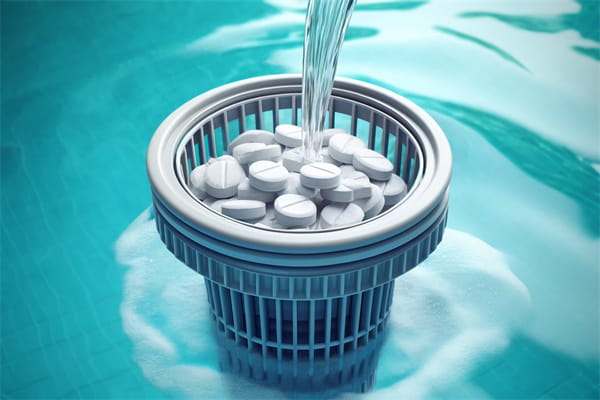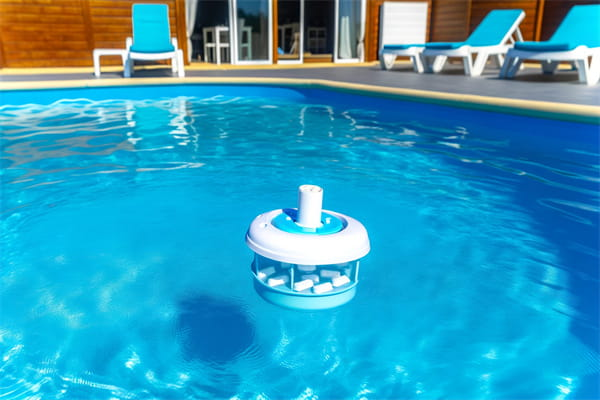Maintaining a pristine pool isn’t just a summer activity; it’s a year-round commitment. Central to this routine is the proper use of chlorine tablets, a popular choice among pool owners for keeping the water sparkling clean and free of harmful bacteria and algae. In this blog, we’ll dive into the nitty-gritty of chlorine tablets—what they are, why they’re so widely used, and most importantly, the best places in your pool to apply them to maximize their effectiveness while ensuring the safety of your swimmers.

Ⅰ. Understanding Chlorine Tablets
Chlorine tablets are compact, concentrated forms of chlorine designed to dissolve slowly and release chlorine steadily over time. They are typically used in residential and commercial pools to maintain a sanitized environment consistently.Compared to liquid chlorine or granular forms, chlorine tablets are lauded for their convenience and efficiency. They reduce the need for frequent chlorine applications, providing a steady dose of chlorine that helps maintain an ideal chlorine level. Furthermore, tablets are less messy and pose fewer hazards when handled correctly, making them a preferable choice for many pool owners.
Ⅱ. Placement Options for Chlorine Tablets
1.Chlorine Feeders
Using chlorine feeders is one of the most efficient ways to apply chlorine tablets in your pool. These devices are specifically designed to work with your pool’s filtration system, providing a consistent flow of chlorine:
How It Works:
Chlorine feeders are connected directly to the pool’s circulation system. As water passes through the feeder, it dissolves the chlorine tablets at a controlled rate, which then gets distributed throughout the pool.
Advantages:
Even Distribution: By integrating with the pool’s pump and filtration system, chlorine feeders ensure that chlorine is evenly spread throughout the pool, which is vital for maintaining balanced water chemistry.
Safety: This method minimizes your exposure to chlorine tablets, thus reducing the risk of chemical burns or inhalation of fumes.
Maintenance Tips:
Regularly check and clean the feeder to prevent clogging.
Ensure that the feeder is calibrated correctly to distribute the right amount of chlorine based on your pool’s volume.
2.Floating Dispensers

Floating dispensers offer a simple and versatile method for chlorinating your pool, suitable for different pool sizes but ideal for smaller or temporary setups:
How It Works:
These dispensers float on the pool’s surface and slowly release chlorine as the tablets inside dissolve. The movement of the water and the dispenser ensures that chlorine spreads throughout the pool.
Advantages:
Flexibility: Easily moved and adjusted, floating dispensers can be used in any pool and removed when not needed.
Cost-Effective: They are generally less expensive than installing a permanent feeder system.
Considerations:
Monitoring Chlorine Levels: It’s crucial to periodically check that the dispenser is functioning correctly and not stuck in one part of the pool, which can lead to uneven chlorine distribution.
Wind and Currents: In outdoor pools, wind and water currents can push the dispenser into corners or other areas where its effectiveness is reduced.
3.Skimmer Baskets
Placing chlorine tablets directly into the skimmer baskets is a common practice but requires careful handling to avoid damage to your pool’s system:
How It Works:
Chlorine tablets are placed in the pool’s skimmer basket, where water entering the filter system dissolves the tablets and carries the chlorine throughout the pool.
Advantages:
Easy to Implement: This method doesn’t require any additional equipment or significant changes to your pool setup.
Risks and Considerations:
High Chlorine Concentration: When the pump starts, water flowing over the chlorine tablets can carry a concentrated dose of chlorine, which might be too intense for the pool’s system and can lead to corrosion or damage over time.
Regular Monitoring: Ensure that the skimmer is not overloaded with tablets and that it is cleared of debris to maintain effective water flow.
Ⅲ. Factors Influencing Chlorine Tablet Placement
1.Pool Size and Type
The size and type of your pool play crucial roles in determining where to place chlorine tablets. Larger pools may require multiple feeders or dispensers to achieve adequate chlorine distribution.
2.Circulation and Dispersion
Good water circulation is vital for effective chlorine dispersal. Ensure your pool’s pump and filter system are functioning correctly to aid in the even distribution of chlorine throughout the pool.
3.Safety Considerations
Always prioritize safety when handling and placing chlorine tablets. Ensure they are placed in locations where they cannot directly contact swimmers’ skin, and avoid areas where children or pets could access them.
Ⅳ. Conclusion
Choosing the right location to apply chlorine tablets in your pool is essential for effective water sanitation and the longevity of your pool’s structural integrity. By using chlorine feeders, floating dispensers, or skimmer baskets appropriately, you can maintain a safe and inviting pool environment all year round.

 Instant
Quote
Instant
Quote Email
Us
Email
Us